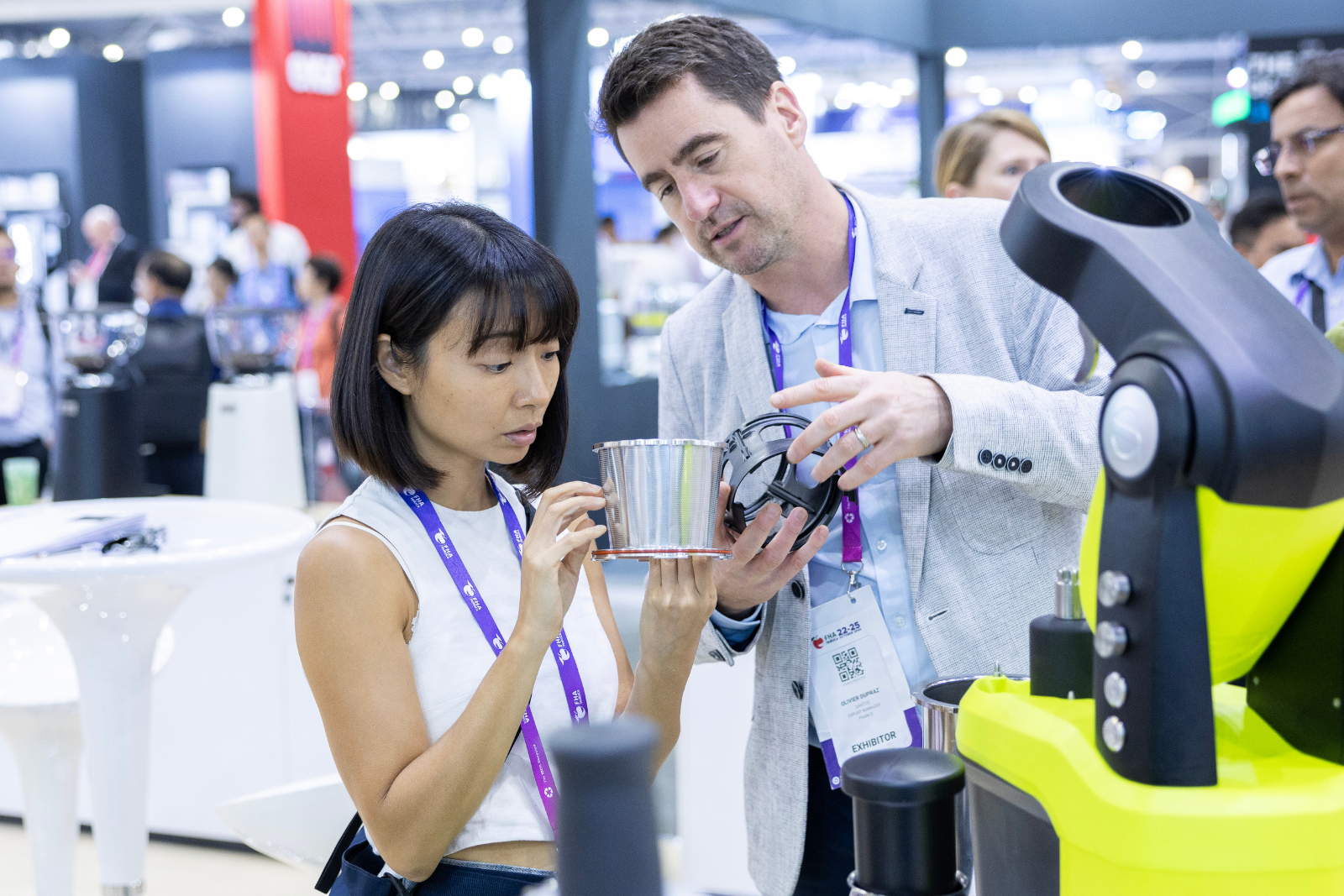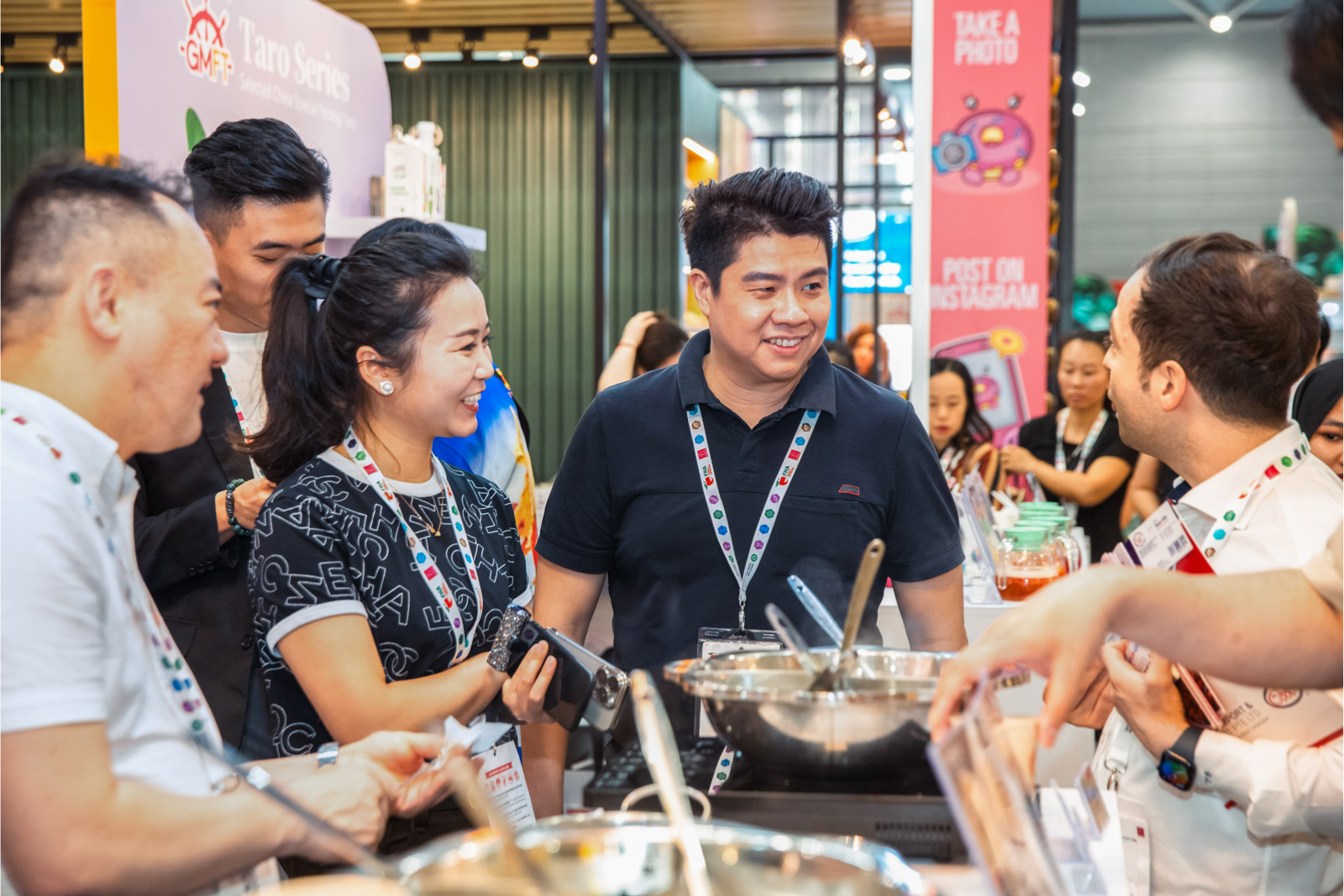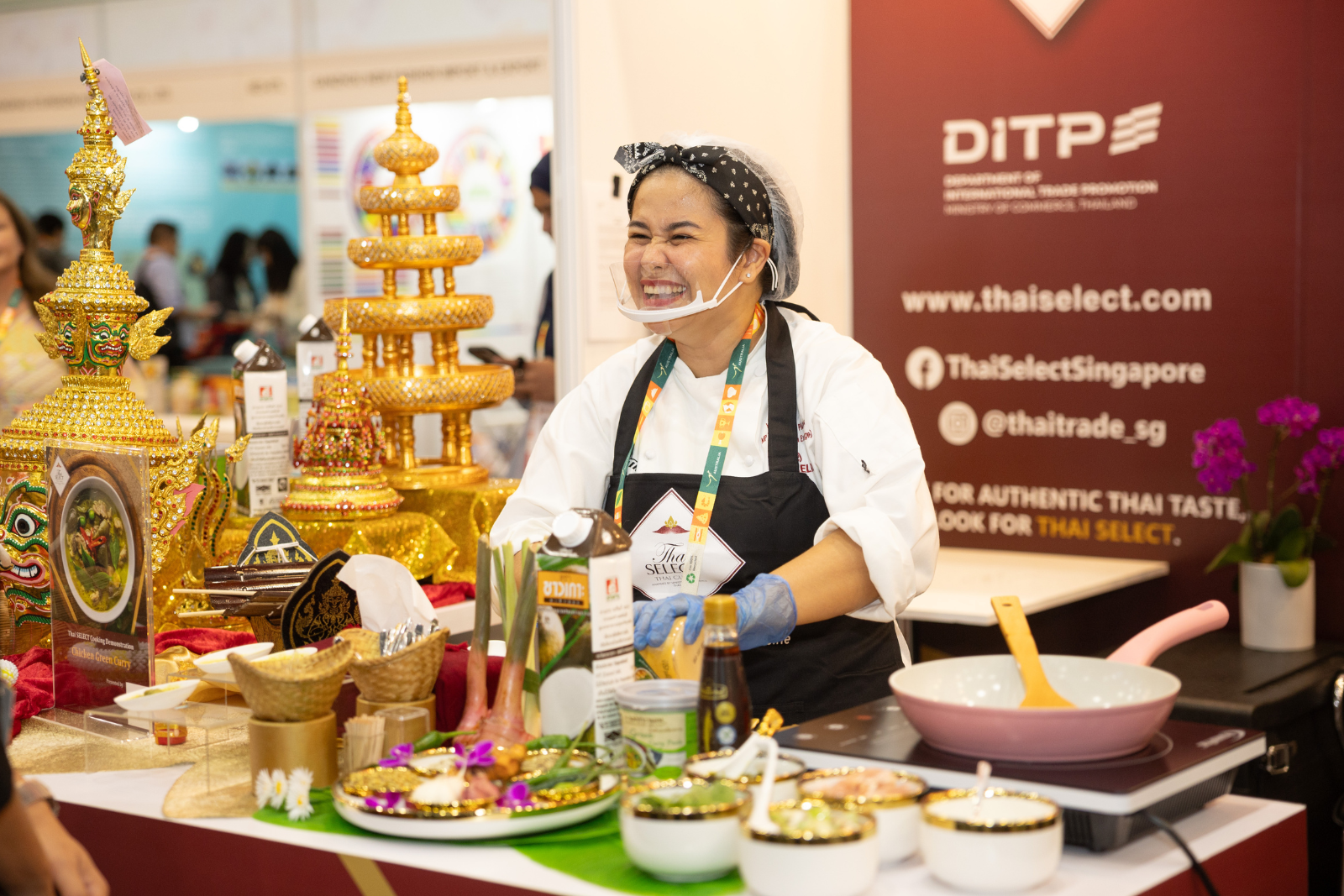A coffee percolator is a timeless coffee-making tool, popular for its ability to brew strong, flavorful coffee. Loved in homes, cafes, and hotels, it’s known for its simple design and the rich, bold coffee it produces.
The secret to a percolator’s unique flavor lies in its brewing process. It cycles hot water through the coffee grounds multiple times, creating a deep, full-bodied taste that coffee enthusiasts cherish. This makes it a favorite for those who enjoy a strong, aromatic brew.
In this article, we’ll explain how to use a coffee percolator, explore the different types available, and highlight why it’s a great choice for hospitality settings.
A percolator might be the perfect solution if you want to elevate your coffee at home or in a business setting.
What is a Coffee Percolator?
A coffee percolator is a classic coffee maker that’s easy to use and loved for its strong, rich flavor. It works by cycling hot water through coffee grounds multiple times, allowing flavors to deepen with each pass.
This unique process makes percolator coffee stronger and more full-bodied than coffee made with other brewing methods, like drip coffee.
Did you know? Coffee percolators have been around for over a hundred years! They became popular in the late 1800s and were used widely in homes and cafes. Even today, many cafes and restaurants choose percolators for their simple design and the bold, flavorful coffee they produce.
Percolators are a cost-effective way to serve quality coffee in hospitality settings like cafes and hotels without needing advanced machines. Guests love percolator coffee’s intense aroma and flavor, making it an attractive choice for establishments aiming to create a memorable coffee experience.
How a Coffee Percolator Works?
The process behind a coffee percolator is unique and helps make the coffee extra strong. Here’s how it works:
- Water Heating and Cycling: Water heats in the lower chamber and rises through a tube. It then flows over the coffee grounds, extracting rich flavors as it cycles back down. This cycle repeats, making the coffee more intense.
- Deep, Full-Bodied Flavor: Because the water passes through the grounds multiple times, percolator coffee has a deep, robust taste distinct from other methods, like pour-over coffee. Many coffee lovers enjoy this full-bodied flavor, especially when they prefer a stronger brew.
Types of Coffee Percolators
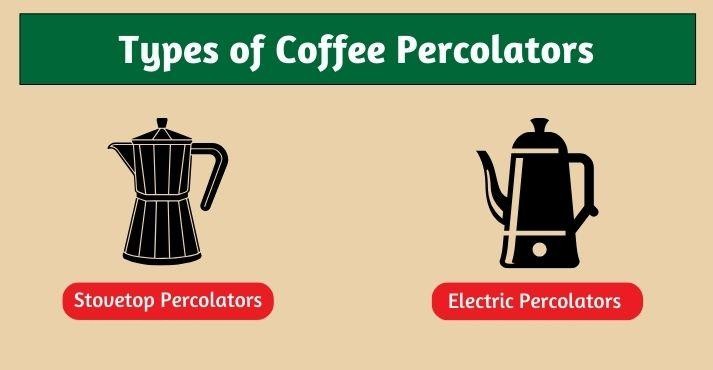
In the world of coffee brewing, coffee percolators hold a special place because they can produce a rich, bold flavor that’s hard to achieve with other methods.
Two main types of percolators are commonly used in hospitality: stovetop percolators and electric percolators. Each type has distinct advantages that suit different settings, from charming cafes to bustling hotel kitchens.
Here’s a closer look at these two popular options and the specific benefits each brings to the hospitality industry.
1. Stovetop Percolators
Stovetop percolators are a traditional, time-tested option for brewed coffee on any stovetop or heat source. These percolators are popular in settings that prioritize simplicity and flexibility, such as smaller cafes, boutique hotels, or catering events.
One of the key features of stovetop percolators is their portability, which makes them incredibly versatile for various uses and locations.
- Portability and Flexibility: Stovetop percolators don’t require electricity, making them an ideal choice for locations with limited power outlets or for outdoor events. They are also lightweight and easy to transport, which is a great benefit for caterers or pop-up cafes that may need to brew coffee in different venues.
- Simple Design and Easy Maintenance: Stovetop percolators are designed with simplicity in mind. Most models are made up of a few basic parts: a water chamber, coffee basket, stem, and lid. This simplicity not only makes them easy to use but also makes cleaning and maintenance straightforward, which is a valuable asset in fast-paced hospitality settings.
- Suited for Small-Scale and Boutique Settings: Because they don’t rely on electric power, stovetop percolators are ideal for small cafes or boutique hotels that may not require a high volume of coffee but want to offer a distinctive, flavorful brew.
2. Electric Percolators
Electric percolators offer a modern twist on traditional coffee brewing by incorporating electric components for automatic brewing. These percolators plug directly into an outlet, which simplifies the brewing process and allows for more consistency in flavor.
Electric percolators are especially popular in high-traffic hospitality environments like hotels, restaurants, and conference centers, where a reliable, efficient coffee brewing solution is essential.
- Consistency and Convenience: One of the biggest advantages of electric percolators is their ability to control both temperature and brewing time automatically. This feature ensures that each pot of coffee has the same rich flavor, eliminating the need for constant monitoring.
- Ideal for High-Volume Needs: Electric percolators are designed to brew larger quantities of coffee, making them well-suited for hotels and restaurants that need to serve coffee to many guests at once. With models capable of brewing up to 12 cups or more, electric percolators can meet the demands of high-traffic areas, such as breakfast service in hotels or events where coffee demand is high.
- User-Friendly Features: Many electric percolators come with additional features that enhance usability and safety. For instance, some models have auto shut-off features, which prevent the coffee from over-brewing and keep it at an optimal temperature. Others include detachable cords, making it easier for staff to transport and serve coffee directly from the percolator.
Benefits of Using a Coffee Percolator in Hospitality
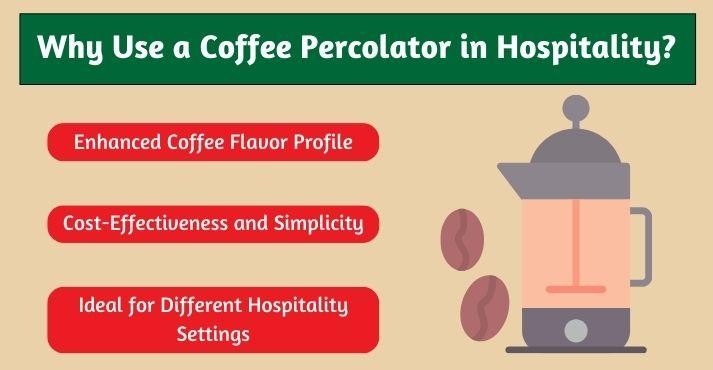
For hotels, cafes, and restaurants, a coffee percolator can be a highly effective brewing option that combines simplicity with the ability to deliver a bold, memorable coffee experience.
Unlike more complicated coffee machines, percolators are easy to use and maintain and offer distinctive flavors that stand out from other methods. Here’s why many in the hospitality industry prefer percolators and how they can elevate the guest experience.
1. Enhanced Coffee Flavor Profile
One of the main reasons percolators remain popular in hospitality is the enhanced coffee flavor they produce. A percolator brews coffee by cycling hot water through coffee grounds multiple times, resulting in a deep, rich flavor profile that appeals to those who enjoy a full-bodied cup.
This unique process makes percolator coffee distinct from other methods, such as drip coffee or pour-over coffee, which tend to produce milder brews.
The full-bodied, robust taste of percolator coffee is particularly appealing in settings where guests expect a strong, aromatic brew to start their day or accompany a meal.
For example, many guests in Southeast Asia, known for its coffee culture, appreciate the bold taste of percolator coffee, which can stand up well to milk and sugar, commonly added by local coffee enthusiasts.
2. Cost-effectiveness and Simplicity
Another key benefit of using a coffee percolator in hospitality is its cost-effectiveness. Compared to espresso machines or high-tech brewers, percolators are relatively inexpensive to purchase and maintain.
They don’t have complex mechanisms, which means there are fewer parts that could break or require regular servicing. This simplicity translates into lower overhead costs, an important consideration for businesses of all sizes.
- Affordable to Purchase and Maintain: Percolators are often a one-time investment and require minimal upkeep. This can be especially valuable for small cafes or boutique hotels looking to manage costs without compromising on coffee quality.
- Easy to Operate: Percolators don’t require advanced training for staff to operate. Unlike more technical coffee machines, which require barista skills, percolators are simple to set up and use, allowing staff to focus on customer service and other responsibilities. For hotels and cafes where staff may be handling multiple tasks, the straightforward design of a percolator ensures that brewing coffee is easy and quick.
3. Ideal for Different Hospitality Settings
Percolators are highly versatile, making them suitable for various hospitality settings, from boutique hotels to larger chain establishments and busy cafes.
Their ability to brew multiple servings of coffee at once makes them an excellent choice for peak hours, allowing businesses to meet high demand efficiently.
- Boutique Hotels and Small Cafes: Smaller establishments benefit from the compact design of stovetop percolators, which can easily be set up on any heat source. Their portability makes them suitable for catering events or outdoor settings, where traditional electric brewers may need to be more practical. For example, a boutique hotel could use a percolator for room-service coffee, allowing guests to enjoy freshly brewed coffee in the comfort of their rooms.
- Larger Hotels and High-Volume Cafes: Electric percolators are perfect for high-traffic areas where large quantities of coffee are needed quickly. With the ability to brew 10-12 cups or more in one batch, electric percolators provide a practical solution for breakfast services, conference centers, or hotel lobbies. When choosing an electric percolator, hotels can ensure they have enough coffee to serve guests during busy hours without delays.
- Event and Catering Services: Percolators, especially stovetop models, are ideal for catering companies that serve coffee at events or outdoor gatherings. Their portability allows them to be used in various locations, ensuring fresh coffee is always available.
Step-by-Step Instruction on Using a Percolator
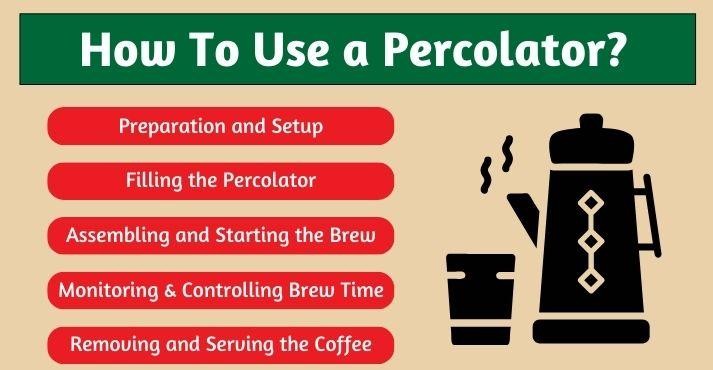
Learning how to use a coffee percolator is straightforward, but each step is essential to achieving the best flavor. Here’s a step-by-step guide to brewing rich coffee using a percolator:
1. Preparation and Setup
- Gather Materials: You’ll need coffee grounds (preferably a coarse grind), fresh water, and a clean percolator.
- Choose the Right Grind: A coarse grind is recommended for percolators to prevent over-extraction and bitterness.
2. Filling the Percolator
- Add Water: Fill the bottom chamber of the percolator with water. The amount depends on the percolator’s capacity and how many cups you want to make.
- Measure Coffee Grounds: A common percolator coffee ratio is 1 tablespoon of coffee grounds per cup of water, but you can adjust to taste.
3. Assembling and Starting the Brew
- Assemble the Percolator: Place the coffee basket on top of the water chamber and add the grounds.
- Start Brewing: For stovetop models, place the percolator on medium heat. For electric percolators, plug them in and switch them on.
4. Monitoring and Controlling Brew Time
- Observe the Percolation: For stovetop models, watch for the water bubbling up through the tube. Adjust the heat if necessary to maintain a steady, gentle percolation.
- How Long to Percolate Coffee: Generally, 5–10 minutes is ideal, depending on the desired strength. Longer brewing will produce a stronger flavor, so adjust as needed.
5. Final Steps: Removing and Serving the Coffee
- Turn Off Heat: Once brewing is complete, remove the percolator from heat or unplug it.
- Serve: Carefully pour the coffee, and enjoy the rich, full-bodied flavor that only percolator coffee provides.
Following these steps ensures a consistent, flavorful cup of percolator coffee every time.
How to Choose the Best Coffee Percolator for Your Business?
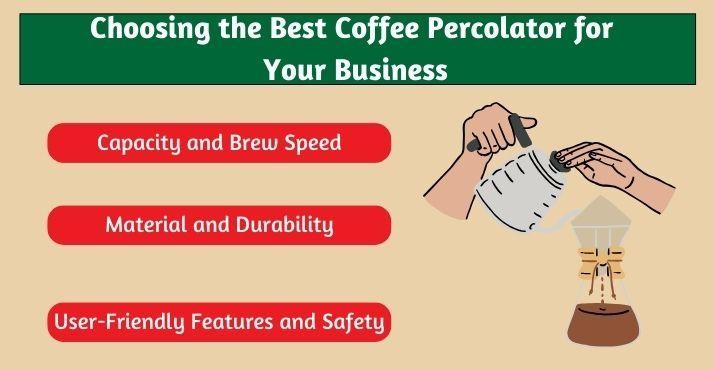
Selecting the right coffee percolator for your hospitality business is essential to ensure efficiency, quality, and ease of use.
With various models available, it’s important to consider the specific needs of your establishment, whether you’re a small cafe, a busy hotel, or a catering service. Here are some key factors to help you choose the best percolator for your business.
1. Capacity and Brew Speed
The size and brewing capacity of a percolator are crucial factors for any hospitality setting. Capacity determines how much coffee can be made at once, so choosing a model that aligns with your volume needs can make service smoother, especially during peak hours.
- Small to Medium Capacity: For boutique hotels, small cafes, or catering events, a percolator with a 4-8 cup capacity may be sufficient. This size is also ideal for businesses where guests expect individual servings or lower-volume service. Small-capacity percolators can be placed on tables for self-service or used in smaller dining areas to offer a fresh, personalized coffee experience.
- Large Capacity: For high-traffic venues like busy cafes or hotels that serve breakfast to large groups, a larger percolator (12 cups or more) is a better choice. These high-capacity models can brew multiple servings at once, reducing the need for constant refilling and ensuring coffee is always ready to serve.
- Quick Brew Speed: Besides capacity, the brewing speed of the percolator matters. Quick-brewing models are especially valuable for high-traffic times, allowing staff to keep up with demand efficiently. When selecting a percolator, look for models with shorter brew cycles if quick turnaround is essential.
2. Material and Durability
In a hospitality environment, durability is a top priority. Percolators used in cafes, hotels, and catering settings must withstand frequent use and rigorous cleaning without compromising on quality.
Choosing a percolator made from durable materials, like stainless steel, can help ensure longevity and reduce replacement costs.
- Stainless Steel: Stainless steel percolators are popular in hospitality because they are sturdy, rust-resistant, and able to handle regular wear and tear. They are also less likely to retain stains or odors, which keeps the coffee tasting fresh. Stainless steel is particularly beneficial in outdoor settings or busy cafes, as it can endure both high usage and various cleaning solutions.
- Heat-Resistant Glass Components: Some percolators include glass components, such as a knob or water level indicator, which allow staff to monitor the brewing process visually. If you choose a model with glass parts, ensure they are heat-resistant and designed for commercial use to avoid potential damage.
3. User-Friendly Features and Safety
In fast-paced hospitality environments, user-friendly features can make a significant difference. Look for coffee percolators with design elements that improve convenience, safety, and ease of cleaning.
These features not only make staff operations more efficient but also add a layer of safety, especially when dealing with hot beverages in a busy setting.
- Auto Shut-Off: An auto shut-off feature is valuable for preventing coffee from over-brewing or overheating. This feature not only preserves the quality of the coffee but also provides peace of mind in case staff get occupied with other tasks. Auto shut-off is particularly useful in settings like hotel breakfast bars, where coffee is prepared in bulk and left for self-service.
- Detachable Cords: Percolators with detachable power cords make it easier to transport and clean the device. For example, if the coffee needs to be served away from the main kitchen, staff can remove the cord and carry the percolator to a designated serving area, enhancing both safety and flexibility.
- Cool-Touch Handles and Secure Lids: In a busy cafe or hotel, safety features like cool-touch handles and securely locking lids can help prevent accidents. These features allow staff to handle the percolator confidently, reducing the risk of spills or burns. Cool-touch handles also make it easier for staff to pour and serve coffee directly from the percolator, streamlining service.
- Easy-to-Clean Design: Cleaning is an essential part of maintaining any coffee equipment. Percolators with removable parts, non-stick interiors, or dishwasher-safe components make cleaning quicker and easier, which is especially helpful in hospitality environments where hygiene is paramount. Easy cleaning features also reduce downtime between brews, keeping the coffee service running smoothly.
Conclusion
Using a coffee percolator is a straightforward way to create a memorable coffee experience for guests. With premium materials, the right grind, and attention to brew time, percolators can deliver a bold, rich flavor that elevates any hospitality setting.
From small cafes to large hotels, percolators are a practical, cost-effective choice that’s easy to maintain and can produce excellent coffee with minimal effort.
In the world of hospitality, it’s these small touches that make all the difference, giving guests a reason to return for another satisfying cup.











